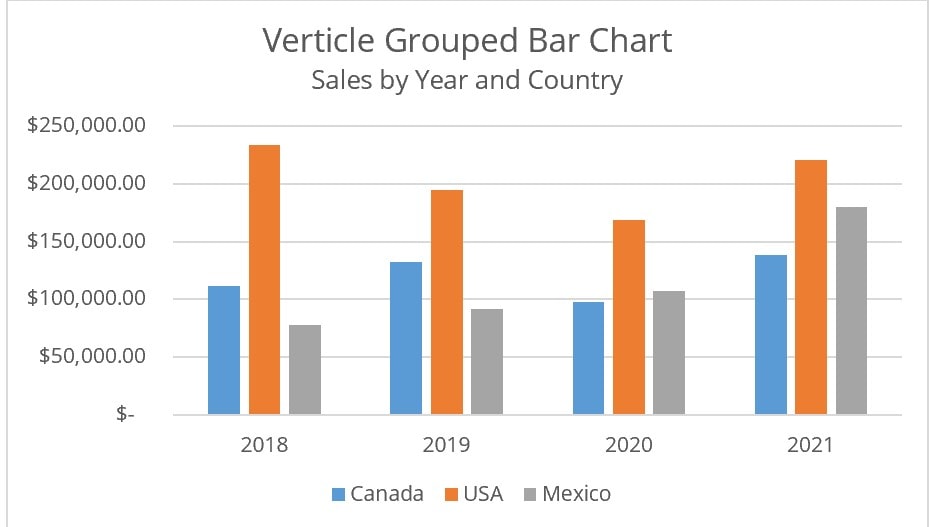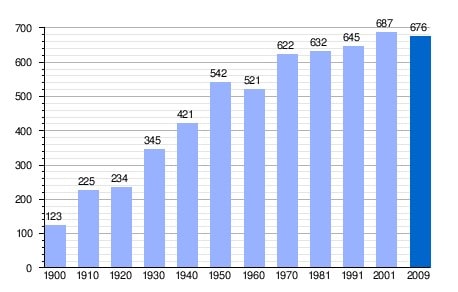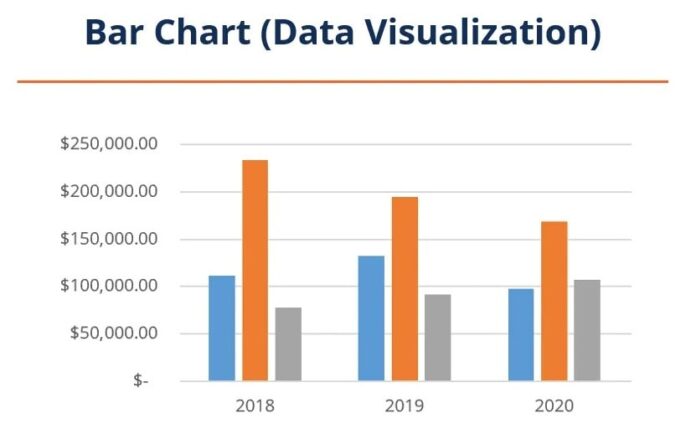Data from several categories may be compared using bar charts, which are graphical representations. They are made up of rectangular bars, each of which height or length corresponds to the value it represents. Bar charts are frequently used in financial research to depict changes in stock values. They exhibit the open, high, low, and close prices for a specified time period (e.g., daily or weekly). By providing a clear visual depiction of price performance, these charts assist investors in understanding trends, swings, and patterns in stock prices. Bar charts may be used to show SpiceJet’s trading volume, price volatility, and general market activity.
What is a Bar Chart?
The Basics of Bar Charts
A bar chart’s primary function is to visually portray data using rectangular bars. The height or length of each bar reflects the value it stands for. can be arranged either vertically or horizontally, based on the user’s taste and the type of data. Usually, the Y-axis shows values, while the X-axis shows classifications. When comparing the amounts of several categories, bar charts are especially helpful. For instance, a bar chart lets you quickly determine which regions are doing better or worse when comparing sales numbers across different regions.
Bar Chart Types
The most popular type of chart for comparing values across categories is the vertical bar chart. The height of each bar indicates the value of the category to which it belongs.
When your category titles are lengthy or the categories are more naturally contrasted along the horizontal axis, you can utilize horizontal bar charts.
Stacked bar charts illustrate how several components work together to form the total. Every bar has parts that correspond to several subcategories.
Grouped bar charts, often referred to as clustered charts, are used to compare many data sets that fall into the same category. To compare sales figures, for example, you may use a grouped bar chart.
Benefits of Bar Charts
Bar charts provide a number of benefits.
Clarity: Data is presented simply, allowing comparisons across various categories to be easily observed.
Versatility: They may be tailored for various comparisons and utilized to show both continuous and discrete data.
Bar charts are an excellent option for conveying facts to a large audience since they are easy to understand and most people are familiar with them.
How to Create a Bar Chart
Collect Data: To begin, gather the information you wish to show. Make sure your data is correct and properly classified.
Select the Appropriate Type: Determine if a vertical, horizontal, stacked, or grouped bar chart is the best option for your data and your message.
Choose a Tool: A variety of programs, including Google Sheets and Microsoft Excel, may be used to produce bar charts.
Data Input: Enter your information in the selected tool. For the majority of tools, you simply enter your data and categories, and the program will create the chart for you.
Personalize the Chart: To make the chart more informative, change the names, colors, and other components.
Examine and Improve: Check your chart for correctness and clarity before completing it.
Introduction to Bar Charts

At its core, a bar chart is a graphical representation of data using rectangular bars. Each bar’s length or height corresponds to the value it represents. It can be oriented either horizontally or vertically, depending on the nature of the data and the preference of the user. The X-axis typically represents categories, while the Y-axis represents values.
Bar charts are particularly useful when you want to compare the quantities of different categories. For example, if you want to compare sales figures across different regions, a bar chart allows you to quickly see which regions are performing better or worse.
Types of Bar Charts
There are several types of bar charts, each suited for different types of data:
- Vertical Bar Charts: These are the most common and are used when comparing quantities across different categories. Each bar’s height represents the value of the category it corresponds to.
- Horizontal Bar Charts: These are useful when you have long category names or when the categories are more naturally compared along the horizontal axis. They offer a clear view of the data, especially when dealing with a large number of categories.
- Stacked Bar Charts: These show how different parts contribute to the whole. Each bar is divided into segments representing different sub-categories, allowing you to see both individual contributions and overall totals.
- Grouped Bar Charts: Also known as clustered, these are used to compare multiple sets of data within the same categories. For instance, you might use a grouped bar chart to compare sales figures for different products within various regions.
Advantages of Bar Charts
How to Create a Bar Chart
Step-by-Step Guide
Creating a bar chart involves a few key steps:
- Gather Data: Start by collecting the data you want to display. Ensure that your data is accurate and categorized appropriately.
- Choose the Right Type: Based on your data and what you want to convey, decide whether a vertical, horizontal, stacked, or grouped bar chart is the best fit.
- Select a Tool: You can create charts using various tools, such as Microsoft Excel, Google Sheets, or specialized data visualization software like Tableau.
- Input Data: Enter your data into the tool you’ve chosen. For most tools, you’ll input your categories and values, and the software will generate the chart for you.
- Customize the Chart: Adjust colors, labels, and other elements to make the chart more informative and visually appealing. Ensure that your chart is easy to read and interpret.
- Review and Refine: Before finalizing your chart, review it for accuracy and clarity. Make sure that it effectively communicates the data and that there are no errors.
Tools for Creating Bar Charts
Several tools and software options can help you create charts:
- Microsoft Excel: Excel is a versatile tool that allows for the creation of various types of charts, including bar. Its user-friendly interface and extensive customization options make it a popular choice.
- Google Sheets: Similar to Excel, Google Sheets offers easy-to-use charting tools. It’s especially handy for collaborative projects due to its cloud-based nature.
- Tableau: For more advanced data visualization, Tableau offers powerful features and customization options. It’s ideal for creating interactive and complex charts.
- Online Chart Makers: Websites like Canva and ChartGo provide user-friendly interfaces for creating bar charts without needing advanced software skills.

Best Practices for Creating Effective Bar Charts
Label Clearly: Make sure that the labels on all of the axes and bars are clear. This facilitates viewers’ comprehension of the chart’s meaning.
Employ Consistent Scales: To prevent inaccurate depictions of the data, keep the axes’ scales constant.
Limit Colors: To prevent overpowering the spectator, choose a limited color scheme. Use only colors that improve contrast and readability.
Prevent Clutter: Make sure the chart is clear and devoid of extraneous components. Make sure the data is presented as plainly as you can.
Give Context: To give context and facilitate chart interpretation, use titles and legends where appropriate.
Analyzing Bar Charts
In order to interpret bar charts, one must examine the heights or lengths of the bars to determine the numbers they represent. You can determine whether categories have greater or lower values by comparing the bars. When examining a bar chart of yearly sales, for example, a larger bar denotes higher sales.
Observe the patterns and trends in the chart. Are there any peaks or valleys that stand out? Do certain groups often rank higher or lower than others? Decision-making can be aided by this analysis, which can offer insights into the data.
Common Mistakes to Avoid
Ignoring Scale: Be sure to keep the axes’ scale in mind. An axis that is not correctly sized in a chart might distort the data.
Ignoring Context: It is simple to misunderstand a chart in the absence of context. Always take the data’s relevancy and source into account.
Make sure you’re comparing like with like when you’re making inconsistent comparisons. Don’t compare data from various categories or times, for example, without taking variations into consideration.
Real-World Applications
There are many different domains and uses for bar charts:
Business: Bar charts are used by businesses to monitor sales, evaluate market trends, and compare departmental performance.
Education: Bar charts are useful for visualizing demographic information, test results, and student achievement in educational contexts.
Healthcare: To monitor patient data, treatment results, and resource allocation, healthcare practitioners employ bar charts.
Government: To display budgetary allotments, economic indicators, and census data, government organizations use bar charts.
Advanced Techniques for Bar Charts
Customization and Design Tips
Interactive features: You may improve the user experience and make the chart more interesting by adding interactive features like tooltips or filters.
Annotations: To draw attention to important facts or patterns, use annotations. This can offer more background and aid in directing the viewer’s attention.
Dynamic Data: Your chart may show changes in real time by using dynamic data updates. Dashboards and real-time data streams benefit greatly from this.
Custom Colors and Styles: Adjust the colors and styles to better emphasize key data points or to fit your branding.
Integrating Bar Charts with Other Visualizations
A more thorough understanding of the data may be obtained by combining bar charts with other display formats:
Combination Charts: Bar charts may be superimposed with line charts or other chart types using combination charts. Comparing several data sets or seeing various facets of the same data might be aided by this.
Dashboards: Include bar charts in dashboards that have tables, pie charts, maps, and other visual components. This comprehensive method offers a deeper comprehension of the information.
Heat Maps: To display the frequency or intensity of data across many categories, combine bar charts with heat maps.
Using Software and Tools Effectively
Make the most of your selected tools’ capabilities by investigating their sophisticated features:
Excel: To construct dynamic bar charts and do in-depth research, make use of sophisticated Excel capabilities like pivot charts and slicers.
Tableau: Create complex bar charts and dashboards by utilizing Tableau’s interactive features and wide range of customization choices.
Google Sheets: Examine how Google Sheets can work together in real time to improve data visualization and how it integrates with other Google services.
Case Studies: Bar Charts in Action
Analysis of Retail Sales in a Business Case Study
A retail business analyzed monthly sales data across several areas using bar charts. They determined the best and worst-performing areas by comparing the bar heights. The organization was able to increase sales in weak areas by reallocating resources and modifying marketing methods thanks to this study.
Case Study on Education: Monitoring Student Performance
Bar charts were employed by an educational institution to monitor student performance in a variety of topics. Teachers were able to pinpoint pupils’ areas of difficulty and adjust their teaching strategies by viewing exam results.
Case Study in Healthcare: Results of Patient Treatment
A medical professional tracked treatment results for several patient groups using bar charts. by contrasting the efficacy of different therapies.
Conclusion
Bar charts are an effective way to compare different groups and visualize data. Knowing how to properly design, evaluate, and modify bar charts will improve your data analysis and communication skills regardless of your level of expertise.




